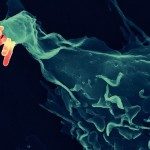Link to Pubmed [PMID] – 23792688
J Vis Exp 2013 Jun;(76):e50116
Shigella flexneri are pathogenic bacteria that invade host cells entering into an endocytic vacuole. Subsequently, the rupture of this membrane-enclosed compartment allows bacteria to move within the cytosol, proliferate and further invade neighboring cells. Mycobacterium tuberculosis is phagocytosed by immune cells, and has recently been shown to rupture phagosomal membrane in macrophages. We developed a robust assay for tracking phagosomal membrane disruption after host cell entry of Shigella flexneri or Mycobacterium tuberculosis. The approach makes use of CCF4, a FRET reporter sensitive to β-lactamase that equilibrates in the cytosol of host cells. Upon invasion of host cells by bacterial pathogens, the probe remains intact as long as the bacteria reside in membrane-enclosed compartments. After disruption of the vacuole, β-lactamase activity on the surface of the intracellular pathogen cleaves CCF4 instantly leading to a loss of FRET signal and switching its emission spectrum. This robust ratiometric assay yields accurate information about the timing of vacuolar rupture induced by the invading bacteria, and it can be coupled to automated microscopy and image processing by specialized algorithms for the detection of the emission signals of the FRET donor and acceptor. Further, it allows investigating the dynamics of vacuolar disruption elicited by intracellular bacteria in real time in single cells. Finally, it is perfectly suited for high-throughput analysis with a spatio-temporal resolution exceeding previous methods. Here, we provide the experimental details of exemplary protocols for the CCF4 vacuolar rupture assay on HeLa cells and THP-1 macrophages for time-lapse experiments or end points experiments using Shigella flexneri as well as multiple mycobacterial strains such as Mycobacterium marinum, Mycobacterium bovis, and Mycobacterium tuberculosis.





